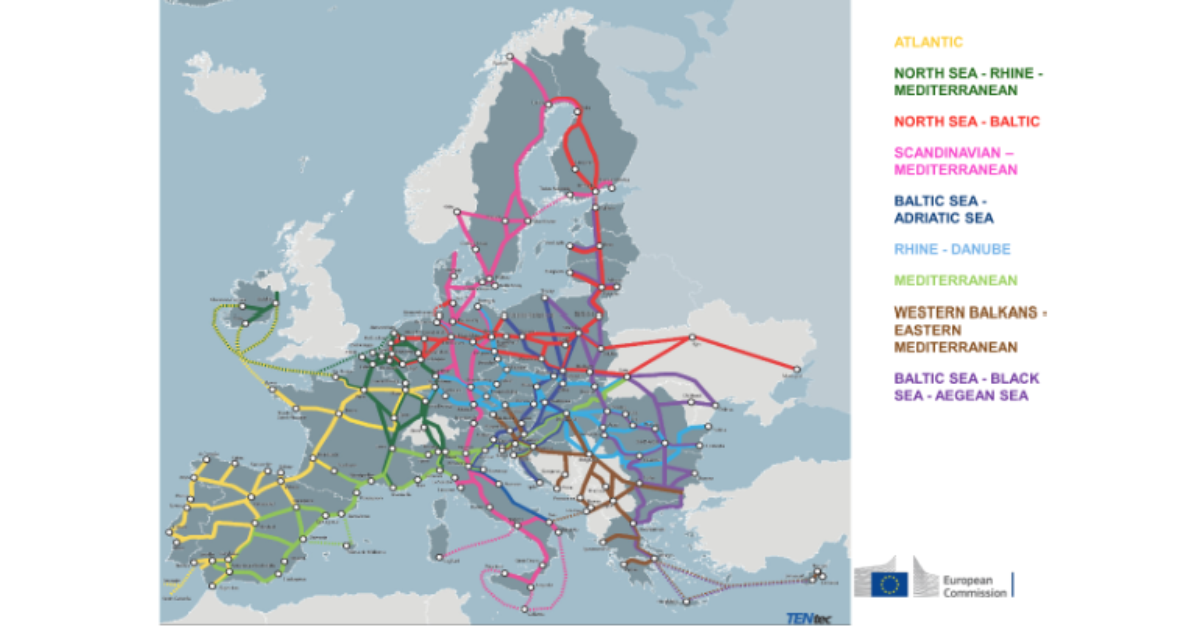
Provisional agreement on TEN-T for sustainable connectivity in Europe
ERRIN has been following the revision of the Trans-European Transport Network (TEN-T) regulation over the past years. In collaboration with the POLIS network, ERRIN has put together a position paper and amendments focusing on strengthening urban nodes and innovation within TEN-T regulation.
The revised TEN-T Regulation should put the transport sector on track to cut its emissions by 90%. It responds to the need to increase connectivity across Europe, foster the resilience of the transport system, shift more passengers and freight to sustainable modes of transport and focus more on sustainable urban mobility.
On December 2023, the Council presidency and European Parliament's negotiators reached a provisional agreement on a revised regulation regarding EU guidelines for the development of the trans-European transport network (TEN-T).
The votes in Coreper (February 9, 2024), TRAN (February 14, 2024), and the Plenary (April 2024) were scheduled to finalise the legislative process, with the Regulation expected to enter into force in May 2024.
Key Features of the New TEN-T
The revised TEN-T introduces a new network structure comprising core, extended core, and comprehensive networks forming the trans-European transport network. The completion of this network is planned in three steps: 2030 (core), 2040 (extended core), and 2050(comprehensive networks). It includes the European Transport Corridors (ETC) and two horizontal priorities, the ERTMS (European Rail Traffic Management System) and the European Maritime Space.
The European Transport Corridors will integrate Core Network Corridors and Rail Freight Corridors, encompassing strategic sections of the core and extended core networks. The corridors have been extended to include four corridors to Ukraine and the Republic of Moldova.
The newly established corridors are:
- Atlantic
- North Sea - Rhine- Mediterranean
- North Sea - Baltic
- Scandinavian - Mediterranean
- Baltic Sea - Adriatic Sea
- Rhine-Danube
- Mediterranean
- Western Balkans Eastern Mediterranean
- Baltic Sea - Black Sea-Aegean Sea
The co-legislators endorsed enhancing the urban dimension of the TEN-T policy by mandating the creation of a Sustainable Urban Mobility Plan (SUMP) for each urban node by 2027. SUMPs are long-term, all-encompassing, integrated freight and passenger mobility plans for the entire functional urban area. These plans may include specific objectives, targets, and indicators to enhance the current and future performance of urban transport systems. All 424 major cities along the TEN-T network are mandated to develop SUMPs to promote zero-emission mobility, improve public transport, and enhance infrastructure for walking and cycling. Additionally, the obligation to establish at least one multimodal freight terminal per urban node by December 31, 2040, where economically viable, remains in place.
What's Next?
The Regulation is expected to enter into force in Q2 2024, setting the stage for the future Connecting Europe Facility (CEF) in 2028. The new TEN-T Regulation will serve as the foundation for assessing investment needs, with the TEN-T Coordinators set to report in Spring 2024.
To address emerging challenges, ongoing studies will analyse the impact of climate change on infrastructure, evaluate investment needs, and recommend adaptive measures. Additionally, high-level working groups chaired by Professor Bergmeister (academic group) and Coordinator Cox (industry group) will focus on the decarbonised construction of transport infrastructure, reflecting the commitment to sustainability and innovation in European transportation.
Have a look at the previous ERRIN work on TEN-T:
- Transport WG joint event with POLIS on urban nodes in the revised TEN-T regulation – July 2023
- Updated regulations and financial instruments: POLIS & ERRIN explore Urban Nodes in the TEN-T – July 2023
- ERRIN-POLIS opinion on the revision of the TEN-T guidelines – May 2022
- Transport WG meeting: Presentation of the 2023-2024 Horizon Europe calls and updates on the ERRIN-POLIS opinion on the TEN-T regulation – September 2022
- ERRIN-POLIS opinion on the revision of the TEN-T guidelines - May 2021
- ERRIN opinion on the revision of the TEN-T guidelines - June 2020
- Gaia Ialisa Marotta
- 16/02/2024
-
Working Group
